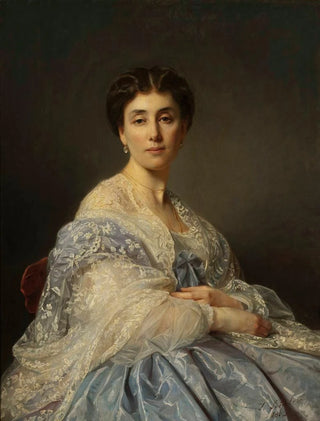Art print | Portrait of the wife of General Aleksandra Zatler - Józef Simmler


View from behind

Frame (optional)
In the rich and diverse panorama of 19th-century art, the "Art print of the wife of General Aleksandra Zatler" by Józef Simmler stands out for its emotional depth and timeless elegance. This piece, both intimate and monumental, invites us to delve into the universe of Polish nobility, while revealing the subtleties of human relationships through the lens of painting. Simmler, through his undeniable talent, manages to capture not only the physical appearance of his model but also her essence, her character, and her social status. Through this art print, the viewer is transported to a frozen moment in time, where every detail tells a story.
Style and uniqueness of the work
Simmler's style is characterized by an impressive mastery of portrait techniques, blending realism and romanticism with unparalleled finesse. In this piece, the chosen colors, the play of light and shadow, as well as the delicacy of the features, testify to exceptional craftsmanship. The gaze of the wife of the generals, both gentle and penetrating, seems to invite the viewer to a silent conversation, while her richly detailed attire evokes the grandeur of a bygone era. The composition, carefully orchestrated, highlights the graceful silhouette of the model, while creating a harmonious balance between the background and the foreground. This portrait is a true ode to female beauty, while also reflecting the values and social norms of the time.
The artist and his influence
Józef Simmler, a prolific Polish painter, established himself as an essential figure of his era. Trained in major European art schools, he integrated various influences into his work while maintaining a strong artistic identity. Simmler was particularly known for his portraits, which, like that of Aleksandra Zatler, reveal a deep understanding of the human psyche. His work not only marked his time but continues to inspire many contemporary artists. By striving to represent his models with such depth, he paved the way for a new approach to portraiture.

Matte finish

View from behind

Frame (optional)
In the rich and diverse panorama of 19th-century art, the "Art print of the wife of General Aleksandra Zatler" by Józef Simmler stands out for its emotional depth and timeless elegance. This piece, both intimate and monumental, invites us to delve into the universe of Polish nobility, while revealing the subtleties of human relationships through the lens of painting. Simmler, through his undeniable talent, manages to capture not only the physical appearance of his model but also her essence, her character, and her social status. Through this art print, the viewer is transported to a frozen moment in time, where every detail tells a story.
Style and uniqueness of the work
Simmler's style is characterized by an impressive mastery of portrait techniques, blending realism and romanticism with unparalleled finesse. In this piece, the chosen colors, the play of light and shadow, as well as the delicacy of the features, testify to exceptional craftsmanship. The gaze of the wife of the generals, both gentle and penetrating, seems to invite the viewer to a silent conversation, while her richly detailed attire evokes the grandeur of a bygone era. The composition, carefully orchestrated, highlights the graceful silhouette of the model, while creating a harmonious balance between the background and the foreground. This portrait is a true ode to female beauty, while also reflecting the values and social norms of the time.
The artist and his influence
Józef Simmler, a prolific Polish painter, established himself as an essential figure of his era. Trained in major European art schools, he integrated various influences into his work while maintaining a strong artistic identity. Simmler was particularly known for his portraits, which, like that of Aleksandra Zatler, reveal a deep understanding of the human psyche. His work not only marked his time but continues to inspire many contemporary artists. By striving to represent his models with such depth, he paved the way for a new approach to portraiture.






